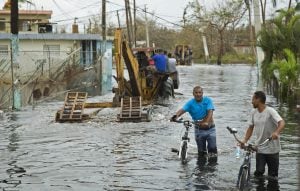Urgent action is required to check the worldwide rise in emissions of greenhouse gases to avoid the worst impacts of climate change, the United Nations Environment Programme (UNEP) warned on October 31 at the release of its Emissions Gap report ahead of the UN Climate Change Conference in Bonn next week.
National pledges made under the Paris Agreement in 2015 will only bring about a third of the reduction in emissions required by 2030 to meet climate targets, creating a dangerous gap, UNEP said in the eighth edition of its report. Even growing momentum from non-state actors cannot currently close this gap, it said.
The Paris climate pact aims to limit the rise of global temperatures below two degrees Celsius compared with pre-industrial levels, which is unlikely to be met unless governments across the world make stronger pledges when the targets are revised in 2020. At the present rate, global temperatures would rise more than three degrees Celsius by the turn of the century, which could have disastrous consequences for life on the planet.
“One year after the Paris Agreement entered into force, we still find ourselves in a situation where we are not doing nearly enough to save hundreds of millions of people from a miserable future,” Erik Solheim, head of UNEP, said in a statement. “This is unacceptable. If we invest in the right technologies, ensuring that the private sector is involved, we can still meet the promise we made to our children to protect their future. But we have to get on the case now.”
The Emissions Gap report comes a day after the Greenhouse Gas Bulletin revealed that carbon dioxide emissions have sharply risen in 2016. The average concentration of CO2 in the atmosphere has hit 403.3 parts per million (ppm), up from 400 ppm in 2015, the World Meteorological Organization (WMO) said, a level not seen on Earth for 800,000 years. “We have never seen such big growth in one year as we have been seeing last year in CO2 concentration,” Petteri Taalas, Secretary-General of WMO, said at the launch of the bulletin.
The emissions gap is the difference between levels required to meet climate targets and levels expected in 2020 if countries fulfil their promises to cut gases that contribute to global warming. The gap reveals how much more needs to be done to keep global warming below the two degrees safe limit agreed upon in Paris.
CO2 emissions have remained stable since 2014, driven in part by the growth in renewable energy, particularly in China and India. This has raised hopes that emissions have peaked. However, the report warns that other greenhouse gases such as methane are still rising, and a global economic growth spurt could easily put CO2 emissions back on an upward trajectory.
Present Paris climate pact pledges make 2030 emissions likely to reach 11 to 13.5 gigatonnes of CO2 equivalent (GtCO2e) above the level needed to stay on the safe two degrees Celsius target, the UNEP report said. The emissions gap in the case of the 1.5 degrees target is 16-19 GtCO2e, higher than previous estimates, it said.
UNEP’s assessment shows that four of the G20 member governments — China, the European Union, India and Japan — are on track to meet their 2020 pledges without purchasing offsets. Another three — Australia, Brazil and Russia — are also on track to achieve their targets.
This article was originally published on India Climate Dialogue








